What is Direct Primary Care? Your Guide To Affordable Quality Healthcare Services
Direct primary care is an affordable alternative to deductibles, premiums, and copayments.

Direct Primary Care vs. Concierge Medicine: What You Need To Know
The struggle to find a better solution to standard healthcare models is not new. In 1996, doctors Howard Maron and Scott Hall founded concierge medicine to answer the call for affordable, quality patient care. Many models have grown from the original, with direct primary care being the most popular. What are the differences between direct primary care vs. concierge medicine?
The Two Faces of Concierge Medicine
It’s easy to be confused by the phrase “concierge medicine.” The term is both an adjective describing a model of healthcare and a noun referring to a specific healthcare model. It’s important to understand that while all direct primary care practices are a form of concierge medicine, not all concierge medicine providers follow the direct primary care model.
“Concierge medicine” describes paying a monthly retainer to a provider in exchange for medical services. This retainer covers standard services and office visits with no limits or additional charges. An example of concierge medicine is direct primary care.
Concierge medicine also refers to a specific model of care, frequently more expensive and limited in its scope of services. For this guide, the term “concierge medicine” refers to this approach.
Direct Primary Care and Concierge Medicine
DPC evolved as a way to take the concept of concierge medicine one step further in achieving the goals of affordable and personalized patient care. Lower pricing, expanded services, and no insurance hassle are the foundations of direct primary care and concierge medicine.
Direct primary care and concierge medicine are similar in their goals: provide quality patient care and a better patient experience.
Both models have fewer patients in their practices, meaning that patients spend more quality time with their providers. Patients enjoy same-day appointments, telehealth services, and—in some practices—home visits.
Direct primary care removes insurance companies from the equation. Unlike concierge medicine and traditional or indemnity insurance, direct primary care places patient care where it belongs: between providers and patients.
A Quick Note About Indemnity Insurance
Indemnity insurance is a “pay as you go” model that provides patients discounted services from participating healthcare providers. Patients are responsible for paying the discounted provider fee.
While indemnity insurance isn’t traditional insurance, it still requires patients to pay copays in addition to the allowed costs for every service or doctor visit. It wields the same power as insurance companies by requiring referrals, denying claims, and capping benefits.
Indemnity plans are not recognized as “health insurance coverage” and are permitted to deny patients based on pre-existing conditions. Some indemnity plans limit the types of care members receive—such as refusing to pay for mental health care or other specialist visits.
Indemnity insurance has all the unpredictability of traditional insurance, and patients frequently find themselves with hefty medical bills in addition to the money they pay for the coverage. The costs for these “health plans” aren’t much lower than traditional insurance, and the amounts still owed by patients following their medical care make indemnity insurance an ineffective and costly option for most people.
What Are the Main Differences Between Direct Primary Care and Concierge Medicine?
While the concept between the two models is similar, there are a few significant differences between direct primary vs. concierge medicine.
1. Concierge Medicine Comes With a Higher Price Tag
Concierge medicine fees are more expensive than direct primary care. Because concierge medicine caters to a wealthier clientele, prices are often cost-prohibitive for most individuals and families.
Concierge medicine requires annual memberships and lengthy contracts, with fees frequently required up-front.
Direct primary care offers patients the affordability of smaller monthly payments with the flexibility of no long-term contracts. If you’re dissatisfied with your plan, it can be canceled at any time with no penalties. Overall, patients save hundreds, if not thousands, of dollars annually by choosing direct primary care vs. concierge medicine.
2. Skip the Insurance Hassle with Direct Primary Care
Providers relying on health insurance payments find themselves answering to those companies when providing patient care. Insurance companies deny claims, refuse to issue referrals, and suggest alternative medications or treatment plans for patients. The providers are caught in the middle as they try to balance the care the patient needs with the care the insurance companies allow.
Deviating from an insurance company’s demands means headaches for patients and providers alike. Because of negative experiences with certain insurance companies, many providers only work with a small, set list of companies.
Unlike direct primary care, concierge medicine continues to work with insurance and bill for services. These bills are in addition to the fees already paid by the patients.
In a sense, concierge medicine still “works” for insurance companies. Anytime insurance is involved, you can expect the unexpected: surprise charges, hyper-inflated costs, copays, and deductibles. In addition, dedicated insurance billers drive up healthcare overhead costs, which are absorbed by patient fees.
Direct primary care doesn’t accept insurance, meaning your care remains in your doctor’s hands while you enjoy a predictable monthly price with no unwelcome surprises. With no insurance hassle, patients save more money with direct primary care vs. concierge medicine.
Tailored MD Direct Primary Care in San Antonio
Hundreds of patients in and around San Antonio, Texas, enjoy the benefits of Tailored MD Direct Primary Care vs. concierge medicine or traditional medical practices.
Tailored MD provides affordable membership fees and a wide array of covered services, including:
- Preventative Health Screenings
- Chronic disease management
- Geriatric care
- Physical exams
- Women’s health exams
- In-home care
- Dermatology
- Weight loss treatment
- In-office lab services
Join Tailored MD and see how direct primary care services solve crowded waiting rooms, limited care, and complex, expensive insurance. Get the quality care you deserve with no long-term contracts, affordable pricing, and no surprise charges or fees at Tailored MD.


